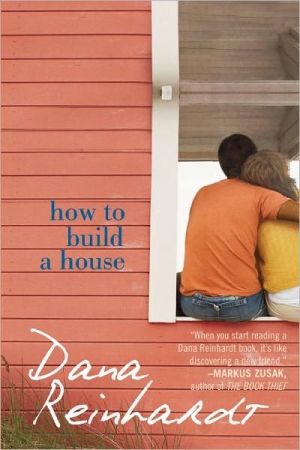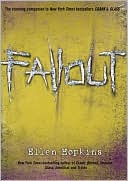How to Build a House
Seventeen-year-old Harper Evans hopes to escape the effects of her father's divorce on her family and friendships by volunteering her summer to build a house in a small Tennessee town devastated by a tornado.
Search in google:
What exactly does it take to build a home and a family that will last forever?Harper's dad is getting a divorce from her beloved stepmother, Jane. Even worse, Harper has lost her stepsister, Tess; the divorce divides them. Harper decides to escape by joining a volunteer program to build a house for a family in Tennessee who lost their home in a tornado. Not that she knows a thing about construction.Soon she's living in a funky motel and working long days in blazing heat with a group of kids from all over the country. At the site, she works alongside Teddy, the son of the family for whom they are building the house. Their partnership turns into a summer romance, complete with power tools. Learning to trust and love Teddy isn't easy for Harper, but it's the first step toward finding her way back home.Publishers WeeklyReinhardt artfully parallels the construction of a house with the reconstruction of a broken family in a work as intimate and intelligently wrought as her previous YA novels, A Brief Chapter in My Impossible Life and Harmless. Shaken by the recent divorce of her father and stepmother and her separation from stepsister and best friend, Tess, Harper Evans jumps at the chance to participate in a summer program in a small Tennessee town, where she and other high school students will build a new house for a family whose home was destroyed by a tornado. Harper aims to bury herself in physical labor to forget about problems back in L.A., but gets sidetracked when she falls in love with Teddy, one of the house's intended residents. Weaving flashbacks of Harper's home life before and after the divorce into the romance between Harper and Teddy, Reinhardt builds a story within a story: one exploring reasons the heroine feels betrayed, the other focusing on how she learns to trust again. This meticulously crafted book illustrates how both homes and relationships can be resurrected through hard work, hope and teamwork. Ages 12-up. (May)Copyright © Reed Business Information, a division of Reed Elsevier Inc. All rights reserved.
The world is drowning.\ Sinking.\ It's being swallowed up. Glaciers are melting. Oceans are rising.\ It's an indisputable fact: We're ruining the planet.\ I'm finding it hard to keep this in mind gazing out my window. From where I'm sitting things look, well, dry. The earth looks thirsty. All I can see is dusty brown. Miles and miles of it stretching on forever.\ Here comes a flight attendant now with her big block of a metal cart to ask me if I'd like something to drink.\ If I'm thirsty.\ I order a diet root beer. She smiles. Diet root beer is not a beverage she keeps in the recesses of her metal cart.\ Okay. Make it a Diet Sprite.\ Out of luck again.\ I take water. No ice.\ I swore off regular soda about a month ago and took up the diet variety. This has nothing to do with my body image, which I'll confess, like most of us, isn't exactly stellar. But this is about something bigger than just my thighs. It's about the national obesity epidemic. It's about taking a stand against the sugar water that's turning our children into Oompa-Loompas.\ So I stopped.\ I know diet soda isn't great for you either, but you have to start somewhere. And anyway, right now I'm drinking water. No ice.\ We're about an hour away.\ I've flown over this part of the country before. Many times. When you live in California and you have relatives in New York, everything in between feels like a big inconve-nience. It's what keeps you from them, or here from there, and you want it out of your way as quickly as possible because your headphones aren't working, and anyway you've already seen the movie three times.\ But today I'm watching that big inconvenience and how it's changed from a flat, endless grid of look-alike houses to snowcapped mountains to red valleys to dusty brown, thirsty earth. Today I'm waiting to be dropped down in the middle of it.\ Tennessee.\ To be more precise, I'm going to Bailey, Tennessee, which almost nobody has ever heard of.\ If you watch TV or read the newspaper or if you have a pulse, then you know about what happened in New Orleans. You know about the hurricane with the name of a princess that left the city underwater.\ But that wasn't the world's last catastrophe.\ Catastrophes come, and they come. They come in all shapes and sizes, one after the other, lined up like planes in the sky, waiting for their turn to land. The tornado in Bailey came this past April, and nobody paid attention except for one small organization with a teen volunteer program where I am spending my summer vacation.\ Sure, the tornado in Bailey wreaked havoc on the lives of an insignificant number of people when you compare it to Hurricane Katrina, but when it's your life . . . I doubt it feels insignificant to you.\ Tornadoes. They're just another indication that the planet is going to hell in a handbasket. A handbasket that's been meticulously crafted and woven by us, the backward-looking members of the human race. If it weren't for how we're ruining things with our trash and our gas emissions and the way we're turning the planet into an Easy-Bake Oven, there might not have even been a category F4 tornado in Bailey, Tennessee.\ Then again, maybe it would have come anyway.\ Tornadoes can happen out of nowhere. Without warning.\ *\ • *\ HOME It's one of those sad stories. I hesitate to even talk about it, because when I do, people start to feel sorry for me, and that isn't necessary.\ My mother died when I was two.\ Okay. Now I've said it. Now I can get that out of the way.\ The important thing is that my dad didn't die. He lived. He still lives. In fact, right now he's probably back at his office, after fighting through traffic from the airport, listening to one of his patients drone on and on, staring out the window. And then he'll see a plane flying overhead with a white, gauzy streak trailing behind it, and he'll wonder why it seemed like a good idea to let me go all the way to Tennessee for the summer.\ This isn't the first time I've run away.\ Once, when we were about eight, Tess and I stuffed a backpack with a towel, some socks and a box of Lucky Charms. We figured what's the point in running away unless someone knows about it?\ So we told Dad.\ He said fine. Just remember, you aren't allowed to cross the street.\ We stopped at the corner and ate a few handfuls of stale Lucky Charms before turning. We turned the next corner, and the next, until we arrived back where we'd started: at our own front door.\ It isn't like that now. I'm running away, and I'm not only crossing the street, I'm crossing this dried-out country and I won't be back for twelve weeks and Dad is going to miss me because he'll be all alone.\ Tess is gone.\ So is Rose.\ So, of course, is Jane.\ He has Cole, sure, but Cole is only six, and what kind of company is a six-year-old who talks to insects? Especially when Dad sees him only some weekends and every other Wednesday night?\ I guess I should start at the beginning.\ There are so many beginnings to choose from. There's me and my birth almost eighteen years ago with my umbilical cord wrapped around my neck, a detail Dad likes to remind me about when I do something particularly boneheaded. There's Mom's death, which although it's an ending, the Big Ending, is also the beginning of my life without a mom. Then there's when Dad met Jane and the beginning of the only family I've ever known.\ Yes. I'll start there.
\ Publishers WeeklyReinhardt artfully parallels the construction of a house with the reconstruction of a broken family in a work as intimate and intelligently wrought as her previous YA novels, A Brief Chapter in My Impossible Life and Harmless. Shaken by the recent divorce of her father and stepmother and her separation from stepsister and best friend, Tess, Harper Evans jumps at the chance to participate in a summer program in a small Tennessee town, where she and other high school students will build a new house for a family whose home was destroyed by a tornado. Harper aims to bury herself in physical labor to forget about problems back in L.A., but gets sidetracked when she falls in love with Teddy, one of the house's intended residents. Weaving flashbacks of Harper's home life before and after the divorce into the romance between Harper and Teddy, Reinhardt builds a story within a story: one exploring reasons the heroine feels betrayed, the other focusing on how she learns to trust again. This meticulously crafted book illustrates how both homes and relationships can be resurrected through hard work, hope and teamwork. Ages 12-up. (May)\ Copyright © Reed Business Information, a division of Reed Elsevier Inc. All rights reserved.\ \ \ \ \ KLIATT\ - Claire Rosser\ Harper's family is in a shambles. Her stepmother, the only mother Harper has known, is moving out and creating a new home for her children (the only siblings Harper has known), leaving Harper to cope with her depressed father. It only makes sense to leave this mess behind for a summer with an opportunity to build a home for a family in a small town in Tennessee, a family who lost their home in a storm. (This is like a Habitat for Humanity project.) The team of builders—older adolescents living in a simple motel for the summer—learn a lot about difficult physical work and about being away from their own families as they create a new sort of family among themselves. The family whose home they are rebuilding is quite remarkable. Their adolescent son, Teddy, connects with Harper, teaching her new lessons about love and family life, as he shares his family with her and as their romance grows. This is fine reading for older adolescents but perhaps a bit problematic for some younger YAs because of the sexual situations, totally believable in a story about older teenagers and college students. Reinhardt handles the family dynamics brilliantly, and Harper's feelings and experiences are well described and will be most appealing to YA readers. Reviewer: Claire Rosser\ \ \ VOYA\ - Leslie Wolfson\ Harper, an environmentally and socially conscious sixteen-year-old, decides to spend her summer with a group of teens from around the country to build a house for a family who has lost theirs in a tornado. Although Harper wants to help others, she is also running away from her problems, struggling with the disintegration of her family, and questioning her sexual relationship with a boy back home. Housed in a run-down hotel, Harper quickly makes friends while learning to handle hammers and power tools. She becomes particularly close with Teddy and his family, for whom they are building the house. Harper learns to appreciate the quietness and peaceful atmosphere of a small town in rural Tennessee, which has a calming effect on her tumultuous life back in Los Angeles. Harper's voice is as engaging as the story. Although Reinhart presents an unlikely plot for a teen novel, it works. The characters and their dialogue are mostly authentic, despite the fact that the teens throw around hundred-dollar words, such as "paradox," "counterintuitive," and "preternatural." The novel's first-person narrative, some of it in flashbacks, switches back and forth between "Home" and "Here." The building of the house is a metaphor for Haley's attempt to rebuild broken relationships and regain purpose during the course of the summer. As the house begins to take shape, Harper's personal life becomes a little less broken. Reviewer: Leslie Wolfson\ \ \ \ \ School Library JournalGr 9 Up- Seventeen-year-old Harper Evans is spending her summer with Homes from the Heart, a teen volunteer organization that is rebuilding a home in Bailey, TN, after the town is hit by a major tornado. Harper, an LA resident, has never built anything, but she wants to help, and she also wants to get away from the havoc in her own life. Her father and stepmother are getting divorced, her sometime-boyfriend Gabriel, with whom she is sexually active, is indifferent, and her beloved stepsister, Tess, is increasingly distant and seemingly hostile toward her. As Harper says, "I know a thing or two about people whose homes have been destroyed. Their lives uprooted. Everything gone." As the summer progresses, Harper becomes increasingly confident as she learns how to handle power tools and flash a doorsill. She also begins to rebuild her own life as she forms new friendships with her fellow volunteers, begins a romantic relationship with the son of the family for whom the house is being built, and eventually moves toward a reconciliation with Tess. This is a thoughtful treatment of what it means to rebuild, not just physical structures, but also lives and families, and the novel emphasizes values such as compassion for others and forgiveness without becoming preachy. Harper is a sympathetic, believable character whose narrative voice expresses wit and heartbreak, and her emotional journey will have tremendous appeal for mature teen readers.-Kathleen E. Gruver, Burlington County Library, Westampton, NJ\ \ \ \ \ \ Kirkus ReviewsSixteen-year-old Harper lost her mother when she was two years old. Her father subsequently married Jane, a lawyer with two daughters, Rose and Tess, who became Harper's best friends. But because of her father's infidelity, Jane has left, and Harper's ideal home has been torn apart. The novel begins with Harper aboard a flight from her home in California to Bailey, Tenn., where she has joined a volunteer project to rebuild a house destroyed by a tornado. Scenes from the past alternate with Harper's present-tense account of her summer to provide background for her emotional travails. There: stepsister Tess seethes at her stepfather's betrayal; here: construction partner Teddy becomes increasingly attractive as more than a building buddy. The author juxtaposes the metaphorical (Harper learns to rebuild her own "house") with the concrete in a well-paced first-person narrative spiced with summer flings and teen romance. Readers will find Harper absolutely charming, even at her most sardonic moments. (Fiction. 13 & up)\ \








